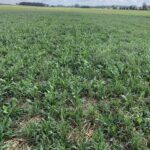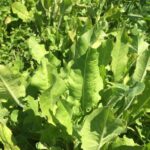Chicory
Cichorium intybus L.
General Description
Chicory is a warm-climate perennial plant of the Asteraceae family. It is a non-legume species.
Chicory produces a rosette of basal leaves the first year, then an erect stem the second year which can then flower. The leaves are mostly located at the base of the plants. The blade is pubescent, very wide, lanceolate, toothed or lobed and green in colour. The single stem measuring 40 to 100 cm is hollow, green to reddish brown and pubescent at the base. The inflorescence is a capitulum formed of ligulate flowers of blue color, rarely white or pink, of 3 cm at the end of the stem or in the axils. Chicory has a deep, branching taproot.
Type
Forbs (non-graminoid herbaceous plants).
Origin
Central Europe.
Longevity
3 years.
Use
Pasture. Once well established, it resists trampling well. It is difficult to dry because it has a high moisture content. Used in rotations, chicory improves soil structure and aeration.
Pasture. This species is especially interesting in pasture. Once well established, it resists trampling well. It is difficult to dry because it is rich in water. Used in rotations, chicory improves soil structure and aeration.
Optimal Time of Use
Spring, summer, autumn.
Recovery After Use
Must be cut or grazed frequently to avoid the development of less palatable stems. Not resistant to overgrazing.
Yield
Chicory has good productivity, although lower than that of alfalfa or red clover.
Palatability/Nutritional Value
Chicory contains sesquiterpene lactones which reduce the risk of bloat and gastrointestinal parasitism. It is rich in water, therefore very tasty. Its nutritional value is excellent due to its low fibre content and high content of sugars, proteins and minerals.
All parts of the plant secrete a bitter milky substance which can negatively affect consumption when in too high a concentration. The content of this substance varies according to growing conditions and cultivar. Few cultivars are currently available on the market.
Annual Precipitation min/max (mm)
N/A
Drought Tolerance
High tolerance to dryness thanks to its deep taproot.
Flooding Tolerance
Sensitive to poor drainage.
Winter Hardiness
Good.
Soil Texture Preference
It grows well on well-drained soils of medium to high fertility and performs less well in heavy soil.
Erosion Control
Poor in pure stand, but good if chicory is sown in mixture with grasses and legumes.
Salinity Tolerance
Good.
Acidity Tolerance
Moderate. Tolerates slightly acidic or calcareous soils (pH 5.5 to 8.0).
Alkalinity Tolerance
Moderate.
Seeds per kg
935,000 seeds/kg (2,057,000 seeds/lb)
Suggested Mixtures
It is not advisable to use chicory in pure culture. Sown in association with legumes and/or grasses, or even with plantain, chicory contributes very well to the yield of the mixture for two years of production following establishment.
Ease of Establishment
Easy.
Competitiveness
Uncompetitive.
Management Considerations
It must be managed intensively to avoid the development of less palatable stems, but it is not resistant to overgrazing.
Guide des plantes fourragères, CRAAQ, 2022 (in press).
NA

